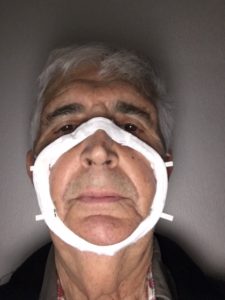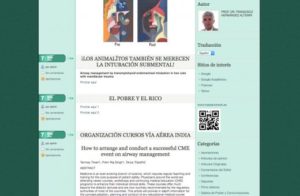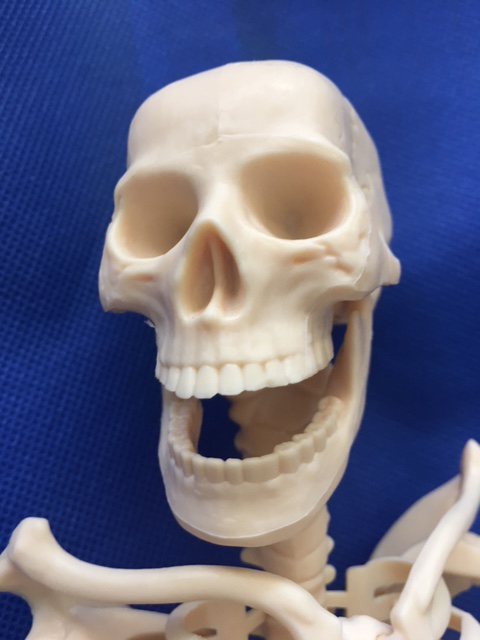Medicine and Oral and Maxillofacial Surgery: Medicine and Oral and Maxillofacial Surgery


PHOTOGRAMMETRY, IMPLANT DIGITAL IMPRESION
Transparent mask

Utility Model Registration Date 10 October 1986
It took effect, in addition to their isolation capabilities, in Operating Rooms, UVIS, Wards, etc., which allow easy identification, the bearer.
The explosion in these initial dates of the 2020 China and some other countries, the Coranovirus, It has taken, as events are occurring, Darla birth again, for possible implementation, Not only, for its primary purpose Protection. Sanitary levels Asistenciales, but also, at times more or less ordinary, in airports and other transport environments and even, In day to day, that can be, in situations agglomeration or more conventional.
Manufacturing estimate, that the times, It should not be difficult, managing to maintain their isolation capabilities, to which were added the facility to recognize carriers and for more human and affective interpersonal exchange form.
BULLETIN 02-2020 – UNIVERSAL HERITAGE OF MANKIND. ANAMNESIS

 Our colleague Francisco Hernández Altemir offers the opportunity to learn more about this issue through the web
Our colleague Francisco Hernández Altemir offers the opportunity to learn more about this issue through the web
http://www.medicinaycirugiaoralymaxilofacial.info:
Submental Intubation: Brief Literature Review and Case Report
Heifer, MCT., Marine, KCT
Submental endotracheal intubation: an alternative to short-term tracheostomy
ALSO they DESERVE THE ANIMALS submental INTUBATION!
Airway management by transmylohyoid endotracheal intubation in two cats with mandibular trauma
THE RICH AND THE POOR
NEUROSURGERY46:6 | JUNE 2000 | 1416-1453 DOI: 10.1097/00006123-200006000-00025 1416 Anatomic Report Unilateral Upper and Lower Subtotal Maxillectomy Approaches to the Cranial Base: Microsurgical Anatomy Tsutomu Hitotsumatsu, M.D., Ph.D.1 , Albert L. Rhoton, Jr., M.D.1 1Department of Neurological Surgery, University of Florida, Gainesville, FlowerUpper maxillectomy The upper maxillectomy yields anterior access to the posterior part of the central cranial base that is limited by the Eustachian tube superiorly and the hard palate inferiorly, even after the pterygoid process is removed (Fig. 5, N–P). Retracting the ipsilateral pharyngeal wall to the opposite side with division of the Eustachian tube produces somewhat limited access to the clivus and C1. Downloaded from https://academic.oup.com/neurosurgery/article-abstract/46/6/1416/2925972 by University of Zaragoza user on 02 January 2020 1449 Intracranial stage Upper maxillectomy Combining the upper maxillectomy with a frontotemporal craniotomy provides intradural access to the anterior and middle cranial fossae, the frontal and temporal lobes, and the basal cisterns by the subfrontal, pterional, pretemporal, and subtemporal routes (Fig. 5, L and Q). Removal of the greater sphenoid wing and floor of the middle cranial fossa opens the superior orbital fissure, round holes, oval, and spinosum, and it accesses the lateral wall of the cavernous sinus (Fig. 5, M–R). Drilling the base of the pterygoid plate exposes the pterygoid canal inferomedial to the foramen rotundum. Entry to the sphenoid sinus is obtained by drilling its lateral wall between the ophthalmic and maxillary nerves, or by drilling the anterior part of the root of the pterygoid process above the pterygoid canal. However, the space between the pterygoid canal and foramen rotundum is limited (Fig. 5S). Continued extradural dissection to the posterior part of the middle cranial fossa exposes the anterior surface of the petrous temporal bone, the trigeminal ganglion in Meckel’s cave, and the greater and lesser petrosal nerves in their grooves on the floor of the middle fossa. Drilling the apex of the petrous temporal bone behind the petrous carotid with opening of the dura accesses the anterolateral aspect of the upper brainstem, although the exposure is very limited. Anterior transposition of the petrous carotid is required to reach the central part of the clivus from this lateral exposure. The lateral access is best suited to exposing lesions at the petroclival junction rather than those centrally located in the clivus. Lower maxillectomy The lower maxillectomy, with removal of the clivus and anterior elements of the upper cervical vertebrae, provides reasonable intradural access to the front of the pons, the medulla, and the cervical spinal cord above C4 as well as the basilar and vertebral arteries (Fig. 4, P–S). The vital structures that provide the lateral limits to the extradural bone removal and the intradural exposure include the petrous and intracavernous carotid, especially the artery on the ipsilateral side; the abducent nerve in Dorello’s canals, particularly the contralateral nerve located at the anterosuperior end of the petrous apex; and the hypoglossal canals and occipital condyles. Opening the basilar venous plexus, which crosses behind the upper clivus and the posterior wall of the sphenoid sinus, may result in profuse hemorrhaging. DISCUSSION Among the various anterior routes to the central cranial base, the route most frequently selected for lesions involving the lower clivus and adjacent vertebral bodies has been the transoral approach (12,13). The upper and middle portions of the clivus are also accessible by the Le Fort I transverse maxillotomy, and the additional median section of either the hard or both the hard and soft palates increases the clival exposure, although Cocke and Robertson (9 ) and Cocke et al. ( 10) conclude that the unilateral maxillectomy provides a more extensive exposure than some bilateral approaches, such as the Le Fort I (1,4,23,28). The hemimaxillectomy approach described by Hernández-Altemir (16) accessed both the transmaxillary and transoral routes. Subsequent modifications and extensions have provided added exposure of both the central and the lateral cranial base, permitting en bloc excision of large neoplasms by selecting and combining the osteotomies on the basis of the extent of disease (7,8,10,15,18,19,21). The osteotomies for completing the upper and lower maxillectomy approaches are divided into four basic units: maxillary body, orbital rim, hard palate, and zygomatic arch; and three extended units: coronoid process, pterygoid process, and frontotemporal craniotomy (Fig. 3). The maxillary sinus is a core space for these approaches through which the retromaxillary area can be reached without violating any vital structure, although the transantral route alone provides very limited exposure (11). Removal of the medial orbital rim provides access to the ethmoid and frontal sinuses, cribriform plate, and the anterior face of the sphenoid sinus through the medial orbital route as in the lateral rhinotomy or medial maxillectomy approach; however, temporary sectioning of the medial palpebral ligament and the nasolacrimal duct usually is necessary (27). If the osteotomy involves the lower orbital rim and floor, the infraorbital nerve must be transected. A palatal osteotomy combined with a cut through the maxillary body below the orbital floor enables transmaxillary access to be combined with transoral access, and increases the anterior exposure of the central cranial base. Zygomatic arch osteotomy facilitates the lateral exposure of the upper part of the infratemporal fossa and the middle cranial fossa by allowing reflection of division of the temporalis muscle. Transection of the coronoid process opens the lateral aspect of the infratemporal fossa and allows early exposure of the maxillary artery for control of bleeding, which is common during the maxillary osteotomy. The sphenoid pterygoid process separates the central from the lateral cranial base and blocks anterolateral access to the central cranial base. Removing the pterygoid process provides exposure extending from the central to the lateral cranial base and allows for wide anterolateral access to the clivus and upper cervical spine. The frontotemporal craniotomy, when combined with an orbitozygomatic osteotomy and removal of the floor of the middle cranial fossa, provides lateral access to the cavernous sinus, the sphenoid sinus, and the petrous apex extradurally, and the frontal and temporal lobes and the basal cisterns intradurally
INDIA AVIATION ORGANIZATION COURSE ROUTE
How to arrange and conduct a successful CME event on airway management
Tanmay Tiwari1, Prem Raj Singh1, Tanya Tripathi2
ABSTRACT
Medicine is an ever-evolving branch of science, which requires regular teaching and training for the core purpose of patient safety. Physicians around the world are attending newer courses, workshops and continuing medical education (CME) programs to enhance their individual clinical skills. These courses offer much beyond the didactic lectures and are now routinely recommended by the regulatory authorities of most of the countries. This article will provide in-depth information for the conceptualization, planning and conduct of any educational medical course with a special reference to airway management. Key words: Accreditation, Airway, Anesthesiologists, Education, Physicians, Continuing medical education-

 PROF. DR. FRANCISCO HERNANDEZ Altemir
PROF. DR. FRANCISCO HERNANDEZ Altemir